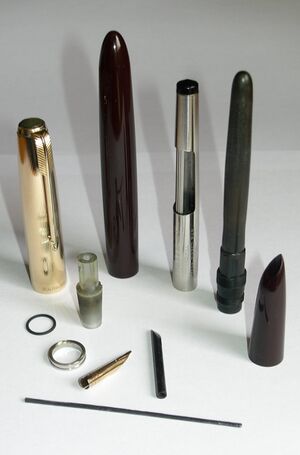Differenze tra le versioni di "Translations:Anatomia di una penna stilografica/1/en"
Jump to navigation
Jump to search

| Riga 1: | Riga 1: | ||
| − | [[Image:Parker-51-Aero-Burgundy- | + | [[Image:Parker-51-Aero-Burgundy-GFCap-Parti.jpg|thumb|Parts of a [[Parker 51]] ]] <onlyinclude> |
The distinguishing characteristic of a fountain pen is to be a tool combining a nib with an ink reservoir in a single writing instrument thus allowing long writing sessions without being continually interrupted by the need to re-dip the nib in the ink. | The distinguishing characteristic of a fountain pen is to be a tool combining a nib with an ink reservoir in a single writing instrument thus allowing long writing sessions without being continually interrupted by the need to re-dip the nib in the ink. | ||
</onlyinclude> | </onlyinclude> | ||
The first real fountains pens appeared around the end of 1800, although there were several predecessors designed for the same purpose, all poorly functioning. | The first real fountains pens appeared around the end of 1800, although there were several predecessors designed for the same purpose, all poorly functioning. | ||
The success in creating a reliable tool that combined an ink reservoir to a nib is often traced back to the introduction of the multichannel feeder by ''Lewis Edson Waterman'' in 1884. Actually at that time there were already several producers who had built working fountain pens, whose essential elements remain the same even today. | The success in creating a reliable tool that combined an ink reservoir to a nib is often traced back to the introduction of the multichannel feeder by ''Lewis Edson Waterman'' in 1884. Actually at that time there were already several producers who had built working fountain pens, whose essential elements remain the same even today. | ||
Versione attuale delle 16:07, 17 ott 2022

Parts of a Parker 51
The distinguishing characteristic of a fountain pen is to be a tool combining a nib with an ink reservoir in a single writing instrument thus allowing long writing sessions without being continually interrupted by the need to re-dip the nib in the ink.
The first real fountains pens appeared around the end of 1800, although there were several predecessors designed for the same purpose, all poorly functioning. The success in creating a reliable tool that combined an ink reservoir to a nib is often traced back to the introduction of the multichannel feeder by Lewis Edson Waterman in 1884. Actually at that time there were already several producers who had built working fountain pens, whose essential elements remain the same even today.